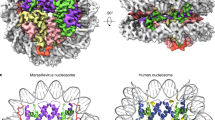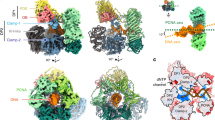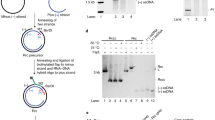Abstract
WHEN DNA is isolated from actively growing animal cells by a variety of standard procedures, 1–2% of the total DNA is recovered in single-stranded form1–5. Pulse labelling experiments have established that the large majority of the single-stranded DNA is not newly synthesised3–5. However, a minor part of this DNA fraction consists of short fragments of newly replicated DNA released by branch migration during isolation6–7. Studies with synchronised human cells have shown that single-stranded DNA is mainly found during the period of DNA synthesis3,4. In agreement with this, a specific antiserum against denatured DNA used for immunofluorescence has revealed the presence of single-stranded DNA in nuclei of a human lymphoid cell line during the S phase but not during the G1 phase8. DNA hybridisation measurements indicate that the single-stranded sequences belong to the non-repetitious fraction of the DNA and that at least part of this material contains sequences transcribed in vivo2. We have developed gentle isolation methods to purify large, covalently closed circular DNA molecules from human lymphocytes transformed by the Epstein–Barr virus (EBV)9. These methods do not cause the conversion of linear double-stranded DNA to single-stranded forms5,9. We have repeatedly observed by electron microscopy long single-stranded stretches of host DNA that initially co-purified with the guanine–cytosine-rich viral episomal DNA. This single-stranded DNA accounted for about 1% of the total cellular DNA in several different lymphoid cell lines derived from Burkitt lymphoma patients or from healthy donors, while the EBV DNA sequences in the same lines only constituted 0.02–0.1% of the total DNA. Clearly, the single-stranded sequences were mainly or exclusively of host origin. Long regions of single-stranded DNA, indistinguishable from those present in EBV-transformed cells, were also found in similar amounts in two EBV-negative human lymphoid cell lines of different origin, BJAB10 and Molt-4 (ref. 11). This report looks at these single-stranded DNA molecules, which are considerably larger than any previously isolated from animal cells.
This is a preview of subscription content, access via your institution
Access options
Subscribe to this journal
Receive 51 print issues and online access
$199.00 per year
only $3.90 per issue
Buy this article
- Purchase on Springer Link
- Instant access to full article PDF
Prices may be subject to local taxes which are calculated during checkout
Similar content being viewed by others
References
Tapiero, H., Caneva, R. & Schildkraut, C. L. Biochim. biophys. Acta 272, 350–360 (1972).
Tapiero, H., Leibowitch, S. A., Shaool, D., Monier, M. N. & Harel, J. Nucleic Acids Res. 3, 953–963 (1976).
Collins, J. M. J. biol. Chem. 252, 141–147 (1977).
Collins, J. M., Berry, D. E. & Cobbs, C. S. Biochemistry 16, 5438–5444 (1977).
Henson, P. J. molec. Biol. 119, 487–506 (1978).
Painter, R. B. & Schaefer, A. Nature 221, 1215–1217 (1969).
Wanka, F., Brouns, R., Aelen, J. & Eygensteyn, J. Nucleic Acids Res. 4, 2083–2097 (1977).
Tan, E. M. & Lerner, R. A. J. molec. Biol. 68, 107–114 (1972).
Lindahl, T. et al. J. molec. Biol. 102, 511–530 (1976).
Klein, G. et al Proc. natn. Acad. Sci. U.S.A. 71, 3283–3286 (1974).
Kawai, Y., Nonoyama, M. & Pagano, J. S. J. Virol. 12, 1006–1012 (1973).
Studier, F. W. J. molec. Biol. 11, 373–390 (1965).
Davis, R. W., Simon, M. & Davidson, N. Meth. Enzym. 21D, 413–428 (1971).
Hampar, B. et al. Nature new Biol. 244, 214–217 (1973).
Jehn, U., Lindahl, T. & Klein, G. J. gen. Virol. 16, 409–412 (1972).
Pettersson, U. J. molec. Biol. 81, 521–527 (1973).
Ellens, D. J., Sussenbach, J. S. & Jansz, H. S. Virology 61, 427–442 (1974).
Robberson, D. L., Kasamatsu, H. & Vinograd, J. Proc. natn. Acad. Sci. U.S.A. 69, 737–741 (1972).
van der Vliet, P. C. & Kwant, M. M. Nature 276, 532–534 (1978).
Bolden, A., Noy, G. P. & Weissbach, A. J. biol. Chem. 252, 3351–3356 (1976).
Waqar, M. A., Evans, M. J. & Huberman, J. A. Nucleic Acids Res. 5, 1933–1946 (1978).
Wist, E. Biochim. biophys. Acta 562, 62–69 (1979).
Spadari, S. & Weissbach, A. J. molec. Biol. 86, 11–20 (1974).
Author information
Authors and Affiliations
Rights and permissions
About this article
Cite this article
BJURSELL, G., GUSSANDER, E. & LINDAHL, T. Long regions of single-stranded DNA in human cells. Nature 280, 420–423 (1979). https://doi.org/10.1038/280420a0
Received:
Accepted:
Published:
Issue Date:
DOI: https://doi.org/10.1038/280420a0
This article is cited by
Comments
By submitting a comment you agree to abide by our Terms and Community Guidelines. If you find something abusive or that does not comply with our terms or guidelines please flag it as inappropriate.



